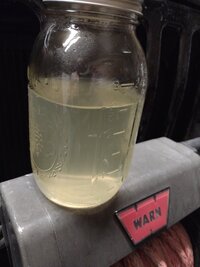No, it rusted because he didn’t add anti-freeze to the water.
You’re confusing two different chemical processes. The first one is the rusting process. Iron in the steel, water (distilled or tap - it does not matter), and air combine to form rust. The hydrogen in the water, the oxygen in the air, and the iron in steel go through a multi-step process to form rust (iron oxide). First iron oxide hydrate is formed, and then it dehydrates, leaving rust behind. Using distilled water doesn’t prevent rust. That is why anti-freeze has rust inhibitors in it. Without those inhibitors, the steel will rust. It doesn’t matter if there are dissolved minerals in the water (“tap water”) or not. Any water without rust inhibitors will form rust in a steel engine block.
The second chemical process is the precipitation of dissolved minerals in the water. The precipitates are carbonates, which won’t re-dissolve in the water. They are that white powder that builds up. This is why tap water shouldn’t be used in a cooling system. Most tap water has dissolved minerals in it (usually calcium and/or magnesium). When the cooling water is heated by the combustion energy, the minerals precipitate out of the water and leave the scale behind. Once it precipitates out, it continues to build up, clogging up the water passages in the engine.
This is why Mr. Blaine recommends a two-step process. First, a de-scaler (I think Prestone is what he uses) is used to remove the mineral scale. Then, Thermocure is used to remove the rust. After the final Thermocure flush, you add coolant, which has rust inhibitors in it, to slow down the rust buildup.
So, use distilled water to prevent mineral scale buildup and use anti-freeze to prevent rusting. Both components in your cooling system are important.


